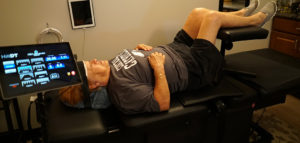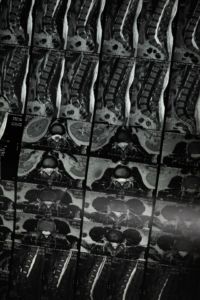Spinal decompression therapy is an innovative treatment proven to reduce low back pain. In a study of patients who had experienced chronic low back pain for at least ten years, over 60 % reported that their pain was completely gone after treatment. In a related study, 80% of patients reported significant improvement in their low back pain. Spinal decompression therapy isn’t a surgery; it’s a non-invasive treatment that can relieve your pain and make you less dependent on pain medication.
Here are six things you should know if you are considering spinal decompression therapy:

What Is Spinal Decompression Therapy?
You may be familiar with old-fashioned traction, where ropes and pulleys are used to stretch and realign the spine. Spinal decompression therapy is mechanized traction. The patient is comfortably secured to a special table during a decompression therapy session. The table is operated by a computer that slowly separates the halves of the table, stretching the spine. The advantage of this method is that the computer can make small adjustments that are impossible to make manually; this allows a level of precision never possible before. Your provider will program the computer with a personalized treatment regimen, and you can stop the program at any time if you feel uncomfortable.
Decompression therapy separates the vertebrae and creates negative pressure within the spine. It’s the only type of traction proven to achieve this. You can think of negative pressure as a vacuum. Many structures within the spine do not receive robust blood flow. During decompression therapy, blood is drawn to the area. This is vital because blood flow and the oxygen and nutrients it delivers are necessary for healing. Negative pressures suck bulging discs back into place and help to clean up leaking fluid from herniated discs that can cause inflammation and pain. Spinal decompression also takes the pressure off of nerves and, for this reason, is typically a comfortable experience.

What Conditions Does it Treat?
Low back pain is a symptom that many things can cause. Spinal decompression therapy excels at treating disc-related injuries and problems with the facet joints. It can also be used for other conditions, including spinal stenosis, sciatica, and Grade 1 or Grade 2 spondylolisthesis. Some people with idiopathic back pain (pain where the cause is unknown) may also find relief from spinal decompression therapy.
While it can and should be used as a first-line treatment for acute and newly chronic back pain, spinal decompression is also a great treatment for those who’ve tried everything. Many patients who have never experienced relief before achieve long-lasting results with spinal decompression.

Are There Any Side Effects?
Spinal decompression is a safe treatment for most people. The most common side effect is temporary muscle soreness. This happens because your muscles are being used in a way they aren’t used to, similar to when you begin a new workout routine. The discomfort should subside within a couple of days after treatment. Most patients only experience soreness after their first few sessions.
As with most treatments, there are some contraindications for spinal decompression. People who are pregnant, have certain cancers, or have a history of aneurysms are not good candidates. Patients with spinal fusions or hardware such as screws or rods in their spine cannot receive spinal decompression.

What If I’ve Had a Failed Back Surgery?
Patients who have had a failed back surgery may be candidates for spinal decompression if they do not have a fusion or hardware and it has been at least six months since the surgery. Many of our patients have finally found relief after failed surgeries.

How Long Does it Take to Work?
Since spinal decompression encourages natural healing, it doesn’t work immediately. Most patients receive between 12 to 20 sessions. These are typically spaced more frequently to begin with, usually at least twice a week, and then taper down over time. Different conditions respond at different rates. Patients with acute disc herniation may experience a temporary increase in pain during the first two weeks of treatment before the herniation retracts and takes the pressure off of nerves. By the end of the second week, most patients experience around a 50% reduction in their pain levels.
The time it takes to get relief breaks down like this: About 20% of patients experience significant relief during the first week, 40% during weeks two and three, and 20% during weeks 4-to 6. Your treatment plan will be personalized to your condition and adjusted as needed. Our providers will always be upfront with you, so you know what to expect at each stage of treatment.
The best part is that relief is long-lasting. Most patients are still feeling better a year after ending treatments. Some patients choose to receive monthly maintenance treatments, but this isn’t necessary for everyone.

What are the Benefits of Non-invasive Treatments?
When considering treatment options, it’s important to weigh the pros and cons of each. Back surgery is necessary for some people, but for many, it is a high-risk, low gain proposition. As many as 74% of low back surgeries fail to provide significant relief. Considering that any surgery comes with risks such as infection, bleeding, drug reactions, and anesthesia side effects, it’s smart to make it a last resort. Non-invasive treatments like spinal decompression therapy offer a better success rate with far less risk.
Spinal decompression is a drug-free treatment, so there’s no risk of interactions or allergies as there can be with certain injections or oral medications. Patients who have to take opioids for their back pain can especially benefit from a non-invasive treatment that allows them to stop taking addictive, risky medications.
Spinal Decompression Therapy in Tennessee
Are you struggling with chronic back pain that gets in the way of your daily activities? At Stanlick Chiropractic, we provide spinal decompression and other non-invasive treatments for low back pain. Schedule a consultation today to get a personalized treatment plan, then enjoy your summer pain-free.

